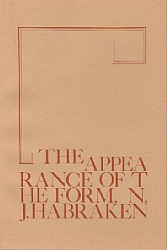|

The Appearance of the Form,four essays on the position designing takes between people and things.
Cambridge, Awater Press, 1985. Second ed. 1988.
______________________________________________________________________________ ____
"But, like flying fish emerging from the dark waves to glitter for a moment in the sunlight, the designed forms, visible in the stark light of explicit discussion must, eventually, disappear in the vast realm of the self evident: the domain of silent understandings which is unquestioned and secure: the domain from where designing rose in the first place."
This small book meditates upon the nature of designing but, where most design theories consider the individual act of creativity and invention, here I seek to distinguish designing from such acts. Designing is just one way in which people can be creative.
Throughout history sophisticated and complex forms have come about and have been produced and modified for long stretches of time without any apparent evidence of designing at all. houses, boats, even grand piano's and other artifacts have been products of collective knowledge without a trace of documentation or description. They are evidence of undeniable creativity, taste, and ingenuity, but we cannot identify a single creator, tastemaker, or inventor.
The things we make and which we use and have around us, are objects belonging to a social body in the life of which they participate and by which they are called into being and from which the duration of their existence depends.. The act of designing seems to occur in special cases. It is a self conscious and explicit act, resulting in an artifact we call ' a design'- which is not the thing itself but its representation. A design is always an extension of the more implicit and anonymous existence of forms which is the norm. Indeed, even highly formalized processes of production and creation, like those applied to the making of airplanes, cars and, indeed buildings, always seem to include an important component of implicit collective knowing of the form, which is not on record and without which the many participants and specializations could not work together to any coherent result.
Essay one: 'Sharing': Explores the collective understanding of complex forms: e.g. the bark canoe among North American Indians, the production of the Grand Piano among craftsmen in a factory, the building of vernacular ships, etc.
Essay two: 'Designing': The act of designing as it emerges from this shared knowing. We begin to see the form appear and gradually come to full description. To succeed in this process of gradual specification the form must remain embedded in a social body and must grow in the context of the largely implicit constraints that body stands for. The distinction between 'creating' and 'designing' becomes crucial, although it is seldom made.
Essay three: 'Seeing': How do we experience forms around us. To see a form it must not only exist in our social space, but we must also share real physical space with it. If we find ourselves in the same space but outside the form, we experience the latter as a machine that 'performs' when we prod it. But a building we experience from inside, it makes the space we occupy. That difference seems important for the relation between us and the things we make. Hierarchy in complex form is another important aspect usually only implicitly understood.
Essay four: 'Controlling': How can we know forms that cannot be seen in their entirety because they are part of still larger forms. How do we know our house from others in a row, our apartment from others in the same building, one room from another in that apartment. How do we see how, among a thousand objects, some belong to a same 'system'. I argue that we can do this because the entities we 'know' are units of control. We understand environment most commonly and most intuitively in terms of control. This brings us back to where we started: the merging of social structure and physical form.
**
Not expecting my musings to raise the interest of many, I decided to have the book printed on my own initiative for distribution among friends and by word of mouth. Hence 'Awater press' is an entity of my own invention. Over the years several hundred copies have found their way in the world. A few are still with me.
****
..; to bibliography overview...to short list...to theory list....to design list....to comprehensive list
|